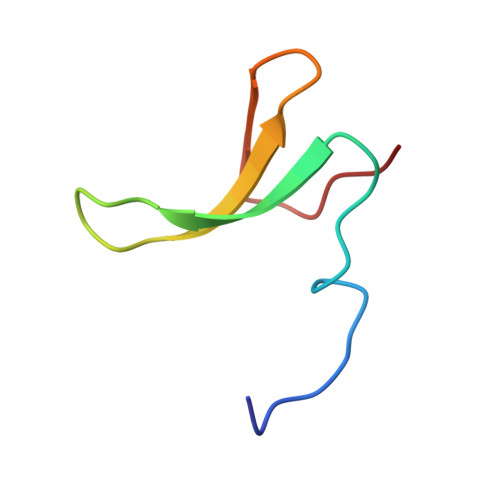Molecular crowding drives active Pin1 into nonspecific complexes with endogenous proteins prior to substrate recognition.
Luh, L.M., Hansel, R., Lohr, F., Kirchner, D.K., Krauskopf, K., Pitzius, S., Schafer, B., Tufar, P., Corbeski, I., Guntert, P., Dotsch, V.(2013) J Am Chem Soc 135: 13796-13803
- PubMed: 23968199
- DOI: https://doi.org/10.1021/ja405244v
- Primary Citation of Related Structures:
2M8I, 2M8J - PubMed Abstract:
Proteins and nucleic acids maintain the crowded interior of a living cell and can reach concentrations in the order of 200-400 g/L which affects the physicochemical parameters of the environment, such as viscosity and hydrodynamic as well as nonspecific strong repulsive and weak attractive interactions. Dynamics, structure, and activity of macromolecules were demonstrated to be affected by these parameters. However, it remains controversially debated, which of these factors are the dominant cause for the observed alterations in vivo. In this study we investigated the globular folded peptidyl-prolyl isomerase Pin1 in Xenopus laevis oocytes and in native-like crowded oocyte extract by in-cell NMR spectroscopy. We show that active Pin1 is driven into nonspecific weak attractive interactions with intracellular proteins prior to substrate recognition. The substrate recognition site of Pin1 performs specific and nonspecific attractive interactions. Phosphorylation of the WW domain at Ser16 by PKA abrogates both substrate recognition and the nonspecific interactions with the endogenous proteins. Our results validate the hypothesis formulated by McConkey that the majority of globular folded proteins with surface charge properties close to neutral under physiological conditions reside in macromolecular complexes with other sticky proteins due to molecular crowding. In addition, we demonstrate that commonly used synthetic crowding agents like Ficoll 70 are not suitable to mimic the intracellular environment due to their incapability to simulate biologically important weak attractive interactions.
Organizational Affiliation:
Institute of Biophysical Chemistry and Center for Biomolecular Magnetic Resonance, Goethe University , Frankfurt, 60438, Germany.














